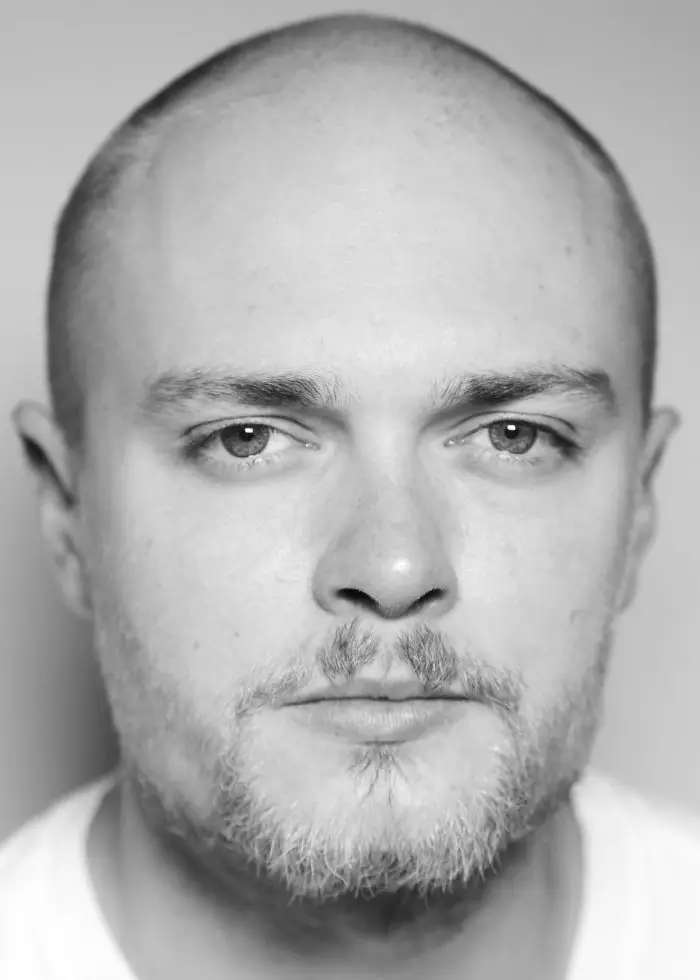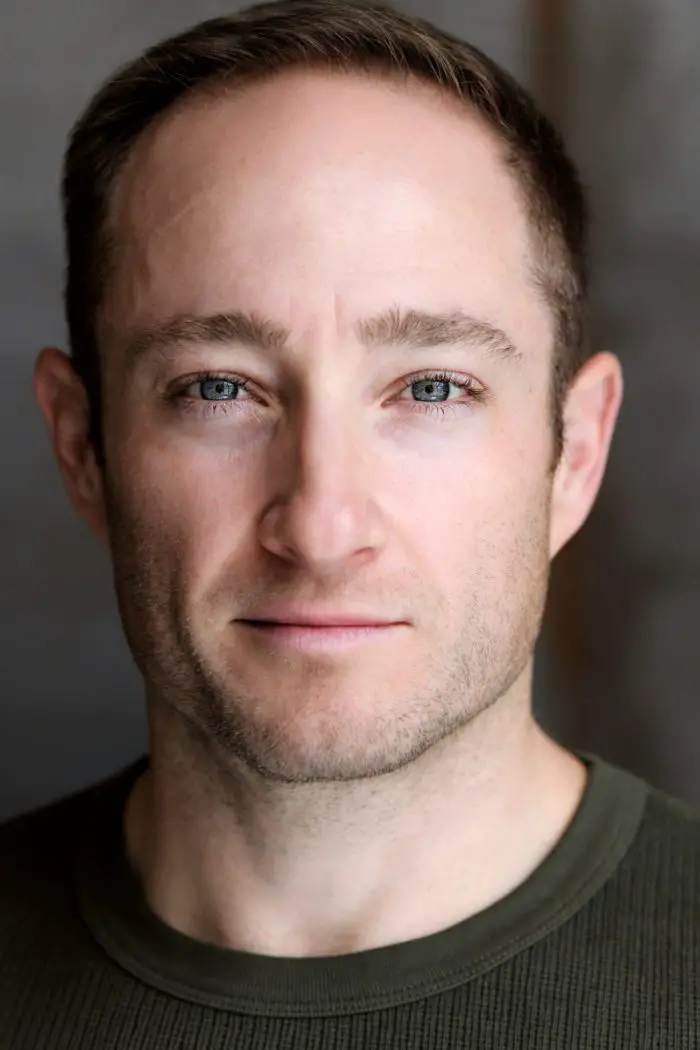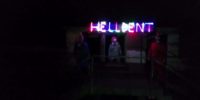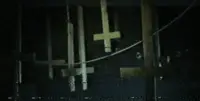Shot in the Dark is a dark and contemplative thriller about a serial killer against a backdrop of small-town angst. The three writers, Kristoffer McMillan, Keene McRae, and Lane Thomas Aikin, navigate both tragic and brutal scenes with an original style, and I had the opportunity for a video call with them all recently.
“It started with an idea,” Kris told me, “just a twist, and then I took a little bit off a real-life story of a killer. It was based a lot on the rumours of the story, which I just loved, and then I brought the idea to Lane, and Lane introduced me to Keene, and we moved forward from there. We’ve been at each other’s throats many times, celebrated when we’ve found something we all agreed with, and ultimately, the writing process never really stopped. It continued right through the editing. One of the main things we kept up with was that it didn’t sound like a movie, but felt more realistic instead. So every time something went against that rule, it felt like trash, no good at all. I wrote the most trash lines in the group.”
“I didn’t write any lines,” said Keene.
“Keene was the one who nixed most of them,” continued Kris.
I reckon sometimes people say “trash lines” in real life too, though. “That’s true,” said Kris, “but in real life, I don’t think the bad guys get to have their big speech at the end. Maybe they do.”
Lane came in: “Maybe bad guys do this stuff just so someone would listen to them!” And the conversation cracks up before it’s barely started until Keene pulled it back into shape.
“The writing process started with Kris. It was his idea, to begin with, and Lane brought me into the fold. Sometimes Lane would give us space, sometimes he’d leave me and Kris to it, but it all basically centered around Kris.”
I couldn’t help wondering why another person kept being added to the group. At what point does this venture suffer from “too many cooks”?
Lane answered that one: “I think it was about having checks and balances, evolving a straight-ahead idea. The twist was quite unique, and that motivated us from the beginning because at the time it seemed this is a never-before-seen twist (or at least one part of it, anyway), and there was a time that was all we had—no real characters initially. That was the part that took the most time and most collaboration. We all ended up acting in the film and having a hand in how these relationships interplayed, and being able to check each other’s perspectives and preferences really helped in order to hit our audience. Also really trying to make sure we were making something new: that was an endeavour from the beginning. If we’re going to do this, it has to be different from other serial killer films. And what would make it different? Well, what would make it different would be if it was a small-town indie drama, with a love story added, some slice-of-life. Those took the most passes from writing perspective.”
“I took something Terry Gilliam said once to heart,” said Kris. “He was asked, ‘How do you come up with all these wonderful worlds and crazy ideas?’ and he said, ‘Oh, it’s real easy, I just hire people that do it.’ Genius! I had a general idea of what I wanted, and both Keene and Lane brought those other pieces, and I could tell when they were the right pieces to work. I didn’t know it was going to be a three-person team, I thought it was just going to be me at first, and this is probably the only project I’ve worked on this way, but it was one of the most fulfilling things to bring these two on board.”
Keene added, “I think it also had something to do with the fact that none of us had made anything before, so we had to just support each other and give each other confidence to keep going.”
I asked whether they were college friends to start with. “No, we met in LA,” said Lane. “Kris and I met by chance on a commercial set in 2009, and he had this idea at that time, and that’s when we started working on it. Keene and I had met in an acting class the year before and become friends, and it was clear to me this was the way to direct our creative careers and efforts towards making something. This was at the beginning of what we can look back [on] and see as the ‘creator empowerment’ time: you have to be a creator, whether that’s now with digital media or in traditional formats, that’s almost a requirement now. With distribution and production models as they are, they work with self-created content. So we saw that writing on the wall, and that’s why we endeavoured to do it. Kris reminded me of another quote we’d seen on a wall, from Spielberg, that ‘it takes one writer ten years to write a great script or ten writers one year,’ so that was another reason we approached it collaboratively. It was going to take some time to make something that would break through.”

Kris had mentioned that the story of Shot in the Dark was based on true events, and when I first saw that on the screen, I felt very dubious. I asked my guests how far the story diverted from real life. “I’d say it was just a hint really,” said Kris, “and then the vehicle went off the cliff!”
“Yeah,” said Keene, “when Lane and Keene got involved!”
“It was very Thelma and Louise at that point,” laughed Kris. “The car went off the edge and everyone held hands…”
“Really, it did come from a true story in Kris’s hometown, which is Eustace, Florida,” said Keene.
“And some of the relationship dynamics were rumoured,” added Lane. “Kris had talked about taking those rumours and running with it.”
Kris picked it up: “It’s been a long time since I’ve spoken to them, but it was from the girlfriend of a character who knew another person kind of thing. They explained what things were like on that last day, and we liked the idea of setting the story on that last day. There was a rumour about the guy convicted, and I was intrigued about the way rumours work and people hook onto them.”
We diverted into the media a little and the way it can influence people. Apparently, the mayor of Eustace had got a little caught up in things back then. “He was going to be a character for a while, but we didn’t have the budget,” said Keene. “We even had the sheriff, FBI, all that stuff in the story. Had to go.”
His mention of Eustace reminded me to ask: is the town where Shot in the Dark is set the place where they all live? Lane answered, “I’m from Reno, Nevada, and that is where we shot a lot of the events. But we invented that setting. We utilised the eastern side of the Sierra Nevada Mountains, all along the California/Nevada border.”
“We got to shoot in a lot of beautiful places and just compile it all together,” said Keene.
Keene is the director of Shot in the Dark as well as part of the writing team, and this was his directorial debut. I asked whether there was a particular decision around this being his first. “It just happened,” he replied. “I don’t know: it was just an opportunity that presented itself. It took a long time though; perhaps I should have done some short films along the way. But it taught us a lot. We all got our hands dirty, we all got behind the camera and the editing bay, and we all got in front of the camera.”
He had mentioned lessons learned in his online bio, so I asked for some examples. “Make sure the script is very good,” Keene said. “Make sure you’ve got a shot list that’s typed out, that you can send to everybody, not handwritten in a book. Make sure you don’t try to do twenty-four shots in a day because on the day, you’re going to have to get rid of half of them. Make sure you’ve got a DP that you trust.”
“We changed DPs multiple times,” Lane added. “As he said, we got on the camera ourselves, each of us, for many shots that made the cut.”
“We all learned how to edit, too,” Keene said. “I could keep going. We learned loads.”
“I think it was the best film school we could have gone to,” said Kris. “The school of hard knocks: get out there and do it. We did try to do this with bigger organisations. We got funded, and then we were not funded; we were funded, and then not funded.”
“There were three or four celebrations,” Lane said.
“Then we decided to just get the money and do it ourselves,” continued Kris.
For most of the film, there was no sign of any budget issues at all, I commented. “Oh I’ll take that!” said Kris. “If that’s the only review we get, I’m pleased.”
“We are all very happy with how we were able to pull this together and with the production quality,” said Lane. “Given that we produced it ourselves, early on in the process, even when the cut wasn’t manifesting into the version of the movie we needed it to be, we could still tell that, hey we’ve got something here. We were able to put something on camera, and then it was a matter of just continuing that process, not giving up, doing rewrites where necessary. We did do those, and not a lot of indie are afforded that time. Maybe because they have that investor oversight, they’re on a tighter schedule, and what they get is what they get, and they stamp it ‘done,’ and if it’s not what it’s supposed to be, oh well. We were fortunate enough that we took on this purgatory of continuing the process until we could really stamp it ‘done’ in a way that we felt proud of.”
Considering Kris had a very central role in the story, I wondered if the others had drawn lots to see if one of them would play the bad guy. “Good point,” said Lane. “I think we liked the idea of working with Austin [Hébert]; he was a good friend of ours at that time, and he had a decent number of credits. We trusted him to come into the role and be able to take hold of the position and the gravity of it. Of course, being an indie film, we were looking for any and all friends we had with some credits that had the potential to up-level the film. It was easier to shoot with him; we all reprised our roles in pick-up shoots three or four times, and Kris probably ten or twelve times. We built that room maybe five different times to get different pick-ups in the torture scenes. And technically, I did play the killer because I body-doubled him at times. You’ll see my hand, legs, butt in there.”

Some of the film’s scenes had been set two or three years before the main body of the story, and I asked what it was like to assemble a film from different time periods like that. “We were kind of lucky,” said Keene. “We shot our flashbacks first because we had a little bit of money just to shoot something, and we chose them. That was smooth, and it all held. So we thought the rest of the shoot would go just as smoothly…but having done none of this before, and trying to do steady-cam movements, I didn’t know it was that difficult and that you had to have a team behind the camera to do that. The flashbacks were kind of out of necessity, but we knew it would play if it took us a while to get the rest of the money: we could use our different looks in the time periods.”
I sometimes wonder when there are flashbacks or cuts in a story how a writer decides at what point to place those. “That was definitely found in the edit,” said Lane. “We had a lot more back sorry or flashback content that didn’t make the final cut.”
“Some of it we couldn’t shoot because of our schedule,” added Keene, “so we had to work around some of the problems. So a lot of the writing happened in the edit.”
“Yeah, which bit of the past should we cut to or in what order?” remembered Lane. “We tried a lot of orders until we found the ones that were really grabbing us.”
Another question about the writing: why was Shot in the Dark set in 1998? “That was the actual time that the incident occurred that inspired us,” said Kris. “And then the oldest outfits we could grab were from that era.”
“And the three of us are all from small towns,” said Lane, “so we resonated with the idea of that being the kind of time that each of us had left those small towns. I remember what it was like growing up in Reno in the ’90s and think about who I would have become if I had stayed. That character and slice-of-life piece also resonated for us. I think it also had to do with the spread of information.”
“It was harder to get people on the phone and see what everyone was up to,” added Keene.
A reliance on TV news certainly featured in the film.
“I remember even not long after that, September 11, 2001,” commented Kris, “when every new bit of information came out, you had to wait for the next day to see what followed. You just had to sit on it overnight and wait, and at the same time took the news as gospel. Today, information doesn’t work like that.”
Communication and information flow have indeed evolved drastically in every decade, and our conversation took another tangent.
“You remember the film When a Stranger Calls?” asked Kris. “’Have you checked the children?’ Caller ID didn’t exist. It was so terrifying when she called the police and they were like, ‘The call is coming from inside the house.’ And when you saw the remake, they had to rely on the police yelling, ‘Oh God, get out of the house!’ but that didn’t work. It’s really important to pick your era well if it’s about the spread of information or misinformation.”
Some themes I’ve noticed a lot in horror films in recent months include grief and looking back at the past. I asked my guests why they might think those seem to be particularly prevalent at this time. “I don’t know if I can speak to anybody else,” said Keene, “but when we started working on this, my Dad was diagnosed with brain cancer. So I had something to personally work through. Kris is a vet so he has experiences that spoke to him and that he might be working through. It was just personal for us, so I don’t know that I can comment on the zeitgeist of everybody else.”
So was it cathartic? All three: “It was.”
Kris continued: “I think everybody experiences grief, but not everybody faces it. The only way forward is to actually face pain, and right now we’ve spent so long not looking at the causes of the pain that when it all backs up, it’s like a dam that broke, and everyone is made to experience it. If it’s coming out in writing right now, I think that has a lot to do with it. That’s a beautiful thing if everyone is coming to face pain and address it together.”
“It is interesting how you point out it’s happening a lot now,” said Lane. “I agree with Keene that this was definitely the attachment to grief and moving on and that it was personal to us; for me, I attach a lot to the small town and my character’s decision to leave. All the obstacles we place in our own way for living the life we want to live need addressing or removing. If I was to guess why we’re seeing more of it now, maybe with everyone having been at home, being quarantined in pandemic conditions, that’s an innately reflective context. We can’t do anything or go anywhere. That means we think about the past and slow down, open up the opportunity to process grief that we’d been pushing down or ignoring.”
“We’re forced to face our truths,” suggested Kris. “I also think that things come down to relationships. When people reflect, they notice cracks, which is something we tried to hit on in the film. You only see movie versions of relationships with big picture stuff, and I thought, you know, let’s focus on real stuff, too. The more real a relationship is in the film, the more people will relate. It was a bit of an experiment, but I think it paid off.”

There were indeed some major cracks showing in Will’s (Kris’s character) relationship with Lili (played by Christine Donlon). I had thought that seeing Will’s typewriter thrown out of the door might have been more painful to him than his torment in captivity. “Yeah,” said Kris. “That’s a part that some people told us never happens. But yeah, it has definitely happened to me: it’s real, and it’s crushing. You can’t condemn the person because they’re justified in their anger, but they might have taken it too far. Everybody does that to each other.”
“You might have taken it too far,” came in Keene, “when you denied her hanging up her painting.”
“Exactly!” said Kris. “For every action, there is an equal and opposite. OK, a little extreme.”
Lane picked up the topic of Will’s torture. “What were the other ideas we had?”
Keene seemed to reminisce: “A needle in the eye.”
I asked all my guests what they have lined up next. Will they continue working together, or are there separate plans? “Both,” said Kris. “I’ve just had a feature funded, but again, until you have the money on the set, on the day, you don’t know. This one’s a horror film, called Something Evil This Way Comes, a comedy which makes fun of the old ’60s film genre. It’s about a preacher and a newlywed couple that are trying to survive a serial killer couple who is hunting them on Route 66, and an alien from outer space, and they all keep missing each other. These guys will definitely be involved in Something Evil and other projects,” said Kris. “I like the idea of putting together a family of people who want to keep creating and help each other out. These are guys I can bet on and I know will pull through.”
“He’s working on another one after that about a tiger, a true story,” said Keene, “and I’m working on one based in 1971 in America in the country music scene. We’ve been looking at a bunch of B-movies like Vanishing Point, and I think this one’s going to be really fun, fast, and dirty.”
“And I’m working to champion a script that Kris and I wrote some time ago that actually made it to the semi-finals of the Academy Nicholl screenwriting contest,” said Lane. “A fun fantasy adventure, more of that big summer tent pole type of thing, a real moon-shot if it ever gets funded, but maybe we’ll see it turn into a series or something like that. It’s set in turn of the century London, involving all the mythical creatures of Earth being gathered for a sort of gladiator-style death match.”
Quite a variety amongst them all!
“Well you can never tell which one will get the momentum,” said Lane.
“Oh and I’ve been doing some music videos and stuff like that too,” said Keene.
Talking of momentum, though, I asked whether Shot in the Dark has a distribution deal in place. “Well yeah, we have a deal with Raven Banner in Toronto,” said Lane, “and they’re helping with this premiere at Grimmfest. Then we’re going to A Night of Horrors in Australia, a week after. Then we’d love to get it out into the USA and we’re in talks with a couple of folks through Raven Banner.”
The world premiere of Shot in the Dark takes place on 10 October at Grimmfest in Manchester, and if you are unable to get there, it can also be viewed from home in the Grimmfest virtual edition on 17 October (in a double bill with Motherly).


